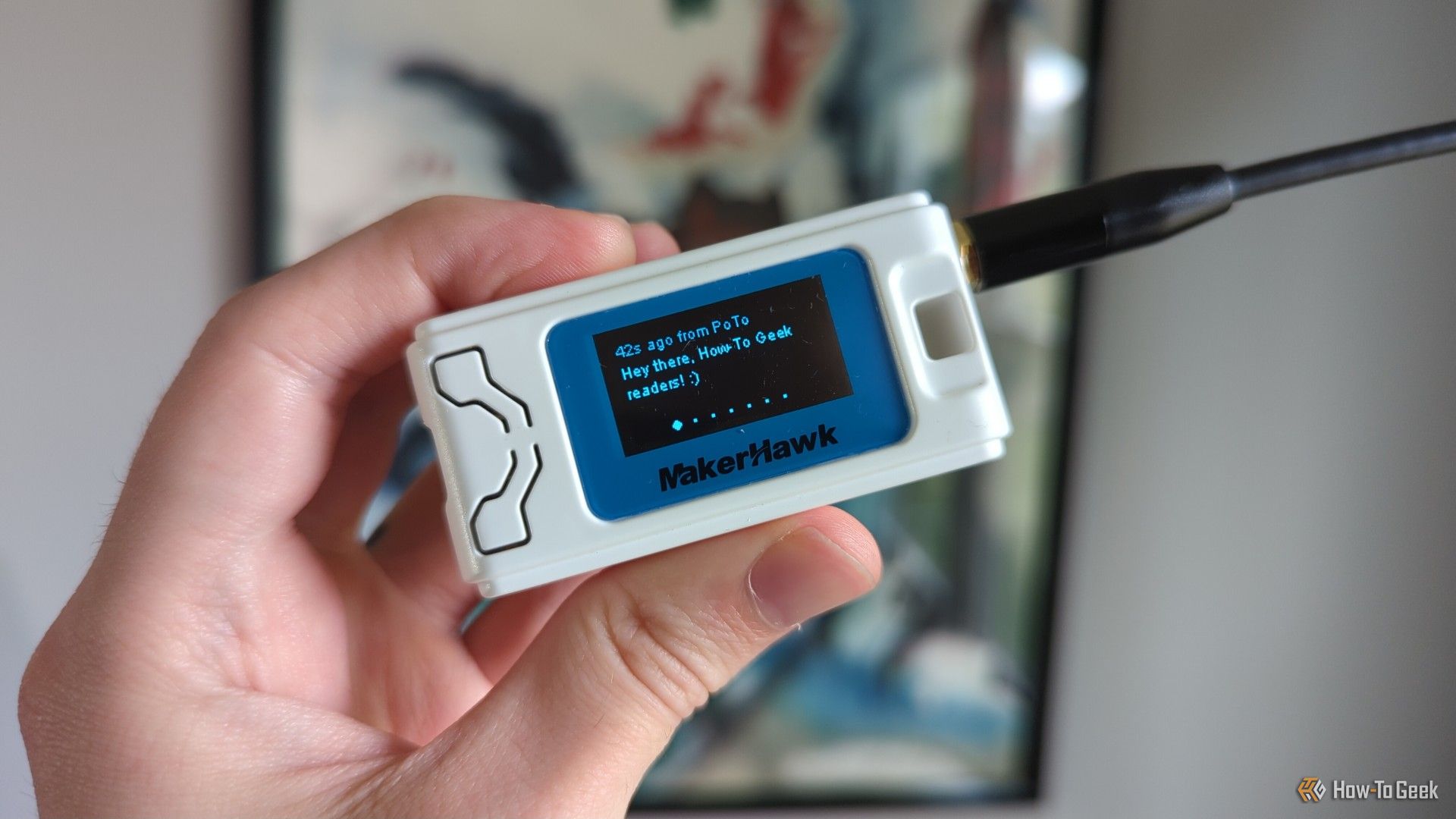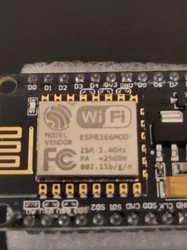Nice article on Meshtastic. The problem is that, like anything, the actual distance is a lot more dependent on line of sight and the actual mesh existing. Which means we’d need a LOT more people to adopt these and put up repeaters for them to be useful. Which is doable, but not cheap.
Have a look at meshmap.net. That shows people who have voluntarily put themselves on a map.
Although it can be a serious underestimation, for example in my area, I’m the only one who lists myself on the map, but there are about 10 other nodes that don’t
Edit: Also, the number of nodes on MeshMap has pretty much doubled in six months since I started playing with it.
Hmm, more than I expected actually. None in my town but one in a nearby town and the nearest city.
Is there a limit to how far can you communicate through multiple nodes? Also is there anything special for setting up a repeater compared to just communicating on the network?
Though i don’t know anyone else that would be likely to use something like this sadly.
They’ve set the maximum at seven hops, but depending on weather conditions, that can easily be several hundred miles.
Nothing special is needed for a repeater except that you probably will want a node with a solar panel such as the seeedStudio solar. You would put it up as high as you can get it. I generally say if it’s more than 100 feet in the air, use router mode. If it is less than 100 feet but above 20 feet, use client. If it is less than 20 feet, use client mute.
Your node in your pocket or in your car should be on client mute mode since them broadcasting will not get the signal much farther and will just cause more channel utilization on high nodes.
Nice, 0 within 25 kilometers of me lol.
Remember, that map is volunteer and only shows nodes of a day or less.
For example, I am the only node in my area who voluntarily puts myself on the map, but there are 10 others who do not.
I always thought these were more like walkie talkies for messaging than telephones that you can call anyone.
Like it would be good if cell serivce goes down.
That’s pretty much exactly what they are. Text message in walkie-talkies. With the added benefit that if your friend can’t hear you, but another friend is in between, your message automatically gets relayed through their walkie-talkie.
If I wanted to transmit, for example, temperature and humidity from a sensor once every 5 minutes, would the network be willing to carry my signals?
https://meshtastic.org/docs/configuration/radio/device/
SENSOR is one of the defined device roles. And whether for personal automation or public information, it is a reasonable use case for the network.
Everything I learn about this project is so cool. I can’t go through the docs right now, but I’m assuming it can prioritize things like emergency communication over sensor data.
There’s no public nodes in a 200+ km radius around me on that site someone linked, so something tells me I’ll have to do a lot of guerilla solar panel installation if I want to anonymously set up something.
I’ve thought about it on and off over the past two years, more of a private network for family and friends than anything, for emergencies and so on. The real, big problem is that I could be accused of espionage and thrown into jail forever if I do this. So I don’t think I’ll see anyone putting any nodes up for the foreseeable future. At least not public nodes.
would the network be willing to carry my signals?
That is entirely up to the whim of your neighboring nodes to decide
Can you message random people or have to already know their contact info?
It is channel-based, using Pre-Shared Keys (PSK).
There is a public line where you can message pretty much everyone with the blank PSK.
Oh, now that sounds fun
Companies are starting to manufacture repeaters and they are not that expensive. You can get one for about 100 Federal Reserve Notes.
Sucks you can’t charge it and have to instead go to a central bank to exchange minted coins for notes that you can exchange for the commodity that is the radio.
“Money can be exchanged for goods and services” - Homer Simpson
Yeah, I’ve seen some clever stuff where they take a solar powered light and wire in a Heltec V3 for $30-$40. But I thought one of the new upcoming standards (WiFi? Cell?) incorporated a mesh capability.
Not that im aware of. SeeedStudio has released a new solar node to be a repeater though
Why not just add networking capabilities or a SIM card?
You can’t expect me not to reinvent the wheel.
As we post on Lemmy, which is a reinvention of a reinvention of a reinvention of Usenet from 1979.
I thought Al Gore invented the internet in the ‘90’s.
Ok, rant time!!!
I worked for Vint Cerf back in the early 90’s. I became aware of the politics around it when Al Gore pushed for funding so the Internet could grow into something bigger than a University/Military communication system. Rush Limbaugh was on the radio daily railing against Al Gore’s Boondoggle. Clinton/Gore secured funding and the Internet exploded in use.
During the 1999 Presidential election, Republicans took Al Gore’s greatest political accomplishment, getting Congress to fund the creation of the Internet, and made it a joke.
Vint Cerf wrote this letter as a result:
So he did invent it?
Eisenhower gets credit for building the Interstate Highway system despite not pouring any concrete.
Eisenhower also didn’t drone strike anyone.
At the very least fathered the internet we know today.
Well, back then it was a bunch of tubes.
At that point, given the extremely small bandwidth, we might as well just use a massive wifi, everyone already has the required hardware for that instead of producing more trash for a pretty much non-existing use case.
This has much greater range compared to wifi
Funny thing about Wi-Fi, it overlaps with an Amateur radio band (the 2.4GHz spec does) and so hams are allowed to run Wi-Fi with no encryption but a tremendous amount of power and high gain antennas on like the highest channels.
A portion of the 5GHz WiFI band overlaps with the 5.8GHz ham band too. There are also a few WiFi radios that will also work above the US WiFi band where they can operate without interference from other license free devices. Those are used in the HamWAN network.
I wonder how much you could Jerry rig up Wimax for these days. That’s like 30 miles of range. I remember thinking if I was only going within a 15 mile area of my place it would have been cool, but prices 10 years ago immediately made it a no.
Edit: like it sounds dumb, but what prevents someone from picking up a used Wimax base station, putting it as an uplink from their router, then using a Wimax card to receive it? Could even maybe just rig up a small rechargable wifi box, that received the Wimax signal, then rebroadcasts it back out as wifi using your home network name/password. So anywhere near your home the antenna would just pick it up and rebroadcast, maybe just hook it to your cigarette lighter to charge so anytime your in the car it’s on. I assume most people would find it easier/cheaper to just buy a cellular card… haha. But hypothetically, I am curious what would make it not work
You can transmit over whatever, but there’s trade-offs with everything. LoRa is kinda neat because it’s low power.
And you don’t need to be a ham to run it.
Might be smarter… wonder if
Ever since I switched to lemmy, I constantly stumble upon people trying to guilt other people for their hobbies. That’s pretty unhealthy.
Whoever reads this, don’t feel guilty living your life. Spend time on whatever you’re passionate about. Build new things, even if they do not have a rational use case at the moment. They might play an important role in your future.
WiFi goes down and people sometimes NEED to communicate instead of streaming Netflix.
This is just an alternate channel, if Eheran doesn’t have the imagination to understand how low bandwidth can still be extremely valuable, as compared to, say, screaming at the top of your lungs to attempt to be heard 5 miles away, then… I’m not really interested in what they think.
“WiFi goes down”
Or more to the point, the ISP fails. A Wi-Fi router isn’t that much more difficult to power than a meshtastic node, but my old ISP, I don’t think they even bothered to install UPSes, if the power was out, so was the internet. I could keep my Wi-Fi up indefinitely, but it’s basically useless outside my house.
Yeah, whenever I tell the kids “WiFi is down” what that really means is “Comcast has killed our link, again.”
They’re a godsend for camping, and would be legendary in a disaster event.
Low power requirements, battery + solar power source… this isn’t science fiction anymore.
People are just discussing the pros and cons of technology in the Technology comm. Chill out.
You can have one or the other. If you choose high bandwidth, you’re going to get very short distance because you can’t do serious error correction, etc. If you choose long range, you’re going to get low bandwidth because you need to include error correction, etc. In the transmissions.
Some people already are
But the point of LoRa is in the name, long range. Wifi barely reaches outside my house. Also a WiFi mesh is dependent on a variety of complicated and proprietary networks and systems while meshtastic is entirely independent.
Isn’t LoRa proprietary? Like, Meshtastic is open source, but something about the radio itself is proprietary tech?
No.
Yes. LoRa (from “long range”, sometimes abbreviated as “LR”) is a physical proprietary radio communication technique.[2] It is based on spread spectrum modulation techniques derived from chirp spread spectrum (CSS) technology.[3] It was developed by Cycleo, a company of Grenoble, France, and patented in 2014.
Did you have a question?
In trying times you’re missing the big picture. If they were more commonplace, you’d have a decentralised communication network that can’t be shut down by the government.
And then they make it illegal to protect the terrorists
pretty much non-existing use case.
…for you.
I can see a use-case where a low-powered off-grid communication device can be useful.
We are in talks to build one for a local power utility. These are cheaper for nice-to-have sensors that aren’t critical. Most electricity meters in Victoria use a mesh network provided through silverspring devices to collect usage readings.
I’ve also heard about a rural water utility using a mesh network to connect water meters together to reduce the number of times an onsite reading is required.
Telcos are already trying to compete with mesh networks by providing low bandwidth LTE-M services that are lower cost for utilities. Nokia are pushing 450connect, 450 alliance, etc as more competitors also.
There are plenty of use cases for low bandwidth systems and services. Isolated network is great when the telcos have pages too.
Clickbait title. Just say it’s meshtastic.
Ok…what’s meshtastic? I still haven’t clicked the article, and know nothing of which you speak.
I’d say this title is for people like me. I think it sounds cool.
It is cool! The barrier to entry is relatively low. The only thing to really worry about is:
- What band/frequency is appropriate for you country.
- Are there others around to which you can connect?
If there’s not a lot of people around it’s not the end of the world. Nodes can connect over the Internet via MQTT servers. Yes, this defeats the purpose of having an offline/decentralized communication platform, but it is a good stop gap until more nodes are put up.
Here’s a sample of what I can see in a somewhat large-ish Midwest City in the US (there’s about 63 nodes I can reach by hopping through relays).

I got mine recently in a dxent aized city and while there are plenty of nodes popping up on the map, the local channel is pretty quiet. Is that normal?
Yep, that can be normal. For my city, the local group has a private (but free to join) channel that’s a bit more active.
Do a web search for meshtastic and your city and see if one pops up.
I don’t know. It’s the same for me but I got a pretty bad reception. The only time I saw some messages was when someone was sending some from a plane, so I guess it was a special occasion.
Where’d you get that map from?
The official meshtastic app has a map view that shows all known nodes.
It allows us to make a mesh network (interconnected nodes where you can contact a node even if it’s not in range for you, by using other nodes) with Lora radio devices. Lora is slow but has long range. I think it works better when you have line of sight, like if someone can put a node on a mountain, it would help everyone.
I think people might have sent audio with it but it’s mostly useful for text messages. It could be useful if the Internet is down, maybe, but it’s more like a toy.
It could be useful if the Internet is down, maybe, but it’s more like a toy.
Since LoRa devices use very little power this can be useful when there is no electricity.
I mean it’s an article for people like me who have never heard of that
Sure, but they could at least put that in the title as well so people who are familiar w/ it don’t need to click through.
Definitely clickbait. The phrase “send texts” as it’s been used for the past quarter century means “sms texts” or maybe “text messages to other people on mobile phone networks”, which is not at all what this is.
Yeah this is not SMS! Its probably text that looks like:
¥¢¥=¶√•€¢√°=¶}{°÷™π™¥π¥¥° °{}}∆∆×÷°%¢¢°{]]×=%π¥®√™%÷Exactly. I was hyped because I’d like to send and receive SMS w/o a mobile phone. I was hoping someone implemented the protocol so I could integrate it into my desktop, the “no wi-fi or cell service” was merely a bonus.
But no, this is just a way to communicate over a different radio protocol than mobile phone standards.
Then what is it?
My wife and I each have a radio, as do several of my friends. They’re handy for anything where you may not have cell coverage, like camping. We also use them at protests, to avoid the heavy surveillance that’s being done on cell networks. Even if the authorities start looking at Meshtastic, everything except the public channel uses PGP end-to-end encryption, and there is no middleman that has access to the unencrypted data.
We have also put up a repeater node. It’s on top of a house at the top of the highest ridge near us. Before it went up we rarely saw more than our own nodes. Now we see several dozen, and sometimes a lot more. And the repeater serves the whole community, not just us. The beauty of a mesh is that everyone contributes to everyone else’s coverage.
The mesh in our city is growing rapidly right now. Not only are there a lot of people getting their own nodes, there are a surprising number of people putting up repeaters to help spread the coverage. It’s amazing to watch our whole neighborhoods suddenly appear as gaps are filled in.
How do I do this? Shats the easiest way to get started?
Both a personal device and a repeater on my house
Easiest and least expensive are a little different, so I’ll talk briefly about both.
The easiest is to go on Etsy and search for Meshtastic. You will find plenty of people who will build you a ready-to-go unit, both individual radios and solar-powered repeaters. (If you plan to put your repeater somewhere with power you can use any radio as a repeater, just put a good antenna on it.) Pre-built units start at around $60 and can go up into the hundreds, but $60 to $90 will get you a great personal radio.
The least expensive is to order a kit from one of the many companies that sell them. If the kit does not come with a case, check Etsy for cases that match your kit. Most kits do not require soldering, you just have to plug in various cables and connectors, then fit everything into the case. Some actually come fully assembled. This approach generally costs somewhere between half and two-thirds of what a pre-built setup will run. Kits start as low as $10, although most or $20 to $40, and cases are mostly $20 to $35.
One of the harder parts is to figure out which radio kit you want, but there are just two major types. Those built around the ESP32 processor tend to be a little less expensive and offer the option of WiFi, but they have a much shorter battery life. Those built around the nRF52 processor cost a little more, do not offer WiFi, but have nearly 10 times the battery life. WiFi is only used in a few specific cases, usually by repeaters and not personal units, so you may well not need it. Battery life is not usually an issue for personal radios, since nearly all of them will go for a full day between charges, but sometimes you may want more than that. Stand-alone repeaters that run off solar panels are almost all based on the nRF52 because of the battery life.
The most common starter radios are based on the Heltec V3 kit, which is based on the ESP32. It has been around a long time, it is relatively inexpensive, and it can do pretty much everything. The only downside is battery life, which may or may not matter to you. Unless that’s a concern, you can’t go wrong with a V3. My personal favorite is the T114 kit, also from Heltec, which is based on the nRF52. It is much like the V3, but without WiFi and with much better battery life.
I would wait until you’ve played with a personal radio before buying a repeater. Every Meshtastic radio acts as a repeater, so you don’t necessarily need a dedicated repeated. Find out how many nodes are in your area and what kind of coverage you get. If there aren’t many nodes, or distance is limited, you can consider a dedicated repeater.
Basically, a repeater is just a node with a good location that’s put in a good location, up as high as possible. Because Meshtastic radios use very little power, it is practical to make completely self-sufficient solar repeater units that never require charging. You can put one of those on your roof, up in a tree, or on top of a nearby hill or mountain, without having to worry about regularly climbing back up there.
I strongly recommend that you go to meshtastic.org and read through the Getting Started documentation. It provides a lot more detail (and less personal opinion). And check out the Meshtastic communities on Lemmy. Have fun!
Thank you for the detailed reply! Yeah I realize now Mestastic.Org has everything I need.
Planning to prolly get:
A rak wireless kit for a local repeater on my roof powered via PoE, and then a TTGO TEcho for my personal device.
I know that I should just get the latter and play with it first, but I live high on a hill with a great vantage point of the city so feels like a disservice to the community if I don’t also host a repeater.
One thing I’m curious about, is if I use it via poe, can I also send messages via the repeater? I.e. locally from my network initiate a message through my repeater?
I would want it in repeater mode so it would forward any message even ones I don’t have the encryption key for.
I don’t think any of the current Meshtastic radios can be used in the usual way via ethernet. Some support WiFi, but not the RAKs that I know about. That leaves USB and Bluetooth.
There is a very neat option that allows you to set up to remotely administer a node via radio. That has saved me a lot of trouble with my repeater. You can’t do everything that way that you could with a direct connection, but you can do most of it.
The repeater will automatically forward messages from your personal radio to anyone who is outside your direct range. You don’t have to do anything special to make that happen. Likewise, any node, including your repeater and your personal radio, will automatically forward encrypted messages without knowing what’s in them. Only the endpoints need to have the encryption keys. Anything in between just forwards the raw data.
Save worthy post. Not the person who asked, but thanks for the extremely detailed response!
I’m glad it was useful to you!
I maintain three of these devices, if anyone has any questions.
What is the range of a device like this? Is there any chance of using a mesh system like that if you’re not in a city? I’m about 30 miles away from a few towns, so there’s little chance for repeaters to be nearby.
Theoretically you can get 50 ish miles or more with line of sight. In practice, you can get around 10 ish with repeaters. With around 30 devices, our city has effective coverage.
You also have options to use MQTT if you want to make sure a message gets through. But that requires an internet connection.
What about without line of sight? If I get one of these is it going to work while it’s sitting on my desk, or am I going to have to mount some antennas on the roof to actually make it usable? The maps only show like three other people in my city with one, so I’m not sure how useful this will actually be for me.
Honestly, its a fun side project, but without enough nodes its more of a hobby. If you want to make it usable, its probably better to use internet or higher power devices (like ham). Or buy a metric ton of these and throw them up high.
As long as you have a node in sight, it should be good for at least some communication. My little window node gets 20+ nodes.
Additionally is there a way to search what’s already out there without a device?
You can, there are websites that show some of the devices. But from what I’ve found, it’s only showing around 1/4 of the real devices in the area. Or at least where I am at.
I’m on the phone so I’m not sure off the top of my head, but I think someone already linked a couple above.
Thanks. I eventually saw that comment and I am just a bit out of range of one listed.
How does this differ from IP over ham radio? It seems like in general, it would just be lower distance and greater reliance on nodes near you, with the trade off being smaller equipment.
https://themodernham.com/ip-over-ham-radio-via-new-packet-radio/
Its biggest + in my book is that you don’t have to be a ham to make it work. There are better systems if you want more reliable communications. But its a fun side hobby and, in the event of a power outage, a decent little communicator. Although from personal experience, most of the devices piggy back of your existing cell phones and bluetooth. So ironically as long as the cell towers aren’t blown to hell, your still fine either way.
You don’t need cell towers. Your phone is just used as an input device for the radio.
There may be some miscommunication. I ment that in order to use a majority of the meshtastic devices, they require the android or ios app + bluetooth. Not all, but a vast majority. And most of those will have access to a cell phone tower that will likely not go down, even in the event your neighborhood power goes off. At least where I am at. The devices have often been alluded to a disaster proof communications device. And an alternative to instant messaging. Its not as reliable as some other tech that is out there, but its a fun hobby!
Hope that makes more sense.
Gotcha. I read your post wrong.
The phones are one reason I don’t think Meshtastic is good for emergency communications. My main Meshtastic devices run off a battery pack that can run them for 2-3 weeks, but I’d also have to keep a phone charged throughout the disaster to use them.
What is the typical power requirement on these devices? Can it be used to set up IoT sensor nodes in the wild where they work off solar, or do they need periodic tuning/care?
I’m running about 1w per device ATM.
So yeah it sips energy. There’s a lot of nodes in the mountains that are solar powered. They work.
That’s a great idea. The area I live in is pretty mountainous so putting nodes on ridges provide pretty good coverage
Very low and yes. They work great for IoT, as long as it’s not mission critical stuff as messages can get dropped or arrive out of order sometimes. But for something like monitoring a remote sensor station that’s within the Lora range, without needing a cellular plan, yes.
What kind of data rate can they provide? Can it support audio? Low bit-rate video?
I’ve seen LoRa when Pine64 announced some related products some years back, but I haven’t really gotten into it. If the community is big enough and the bitrate reasonable enough, I might get one to connect my home to my parents home (about 10 miles away, so at the edge of the range) for fun. It would be cool to set up some smart home stuff at both ends that I could host on my own so I can keep an “eye” on my parents stuff when the travel (mostly just door and occupancy sensors, no video).
In theory the protocol can support those formats. With meshtastic it’s only designed for text. You can get some really basic emojis though since they are Unicode.
If its simple enough, I could probably abuse it to send binary data by encoding everything in base64 or something, and writing a simple translator for whatever my app is.
But what does the usable bandwidth look like, and what about latency? If I’m going just out of range from direct communication, I assume I’d be going through other peoples’ nodes, but is that intelligent enough to route messages through efficiently? Or could I see crazy latency spikes?
You are at the edge of what I know :) If you find out, let the rest of us know. I only have vague and hand wavy knowledge at this point of lora slow means lots of latency. GL!
I got mine recently in a dxent aized city and while there are plenty of nodes popping up on the map, the local channel is pretty quiet. Is that normal?
Yeah, we had to make a weather app on longfast to fill the void. Tech people tend to not talk all that much. We are the strange ones ;)
Most of the weather app was made from a reddit post back a year or so ago. I have no idea where though. App is a python script here if your interested.
The maps do not show any devices in the country where I live, but due to the low cost and practical use, I’d love to set some up.
If i am usually within 6km of my home, in a city. I wonder if 1 node will be enough coverage.
Also, how can you tell that there are more nodes than reported on those sites?
The phone app gives the location of nodes want you to know. And most don’t care. For example, in my city there is currently 24 online nodes my window node has interacted with. And 174 in total nodes it’s contacted today.
It can be spotty during certain times of the day.
Man I’ve been seeing so much about these over the last few weeks, I’d love to get my hands on one
I just picked up a 2pack of devices from the Amazon link in that article. Planning on messing with them this weekend. I figure I’ve spent more than $60 on random projects that went nowhere before, so this can’t be that bad.
I sent this link to a friend who’s really into internet radio (like CB used to be cool for nerds) who also loves to 3d print. He lives in a plains state, where this should work really well.
LoRa has been around for a while trying to break through with different devices, some of it does seem useful, but it’s a tough sell to invest in something without knowing where the network will go. A carrier model or something else, maybe subsidies, is needed.
Not much bandwidth to know do much beyond text, so use-cases are probably very limited already.
SMS style communication?
Even for that LoRa can basically only act as a bridge, unless LoRa radios start being built into phones instead of being separate devices.
I feel like I saw some device that could do both posted on Lemmy not that long ago.
deleted by creator
























